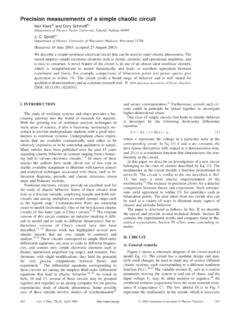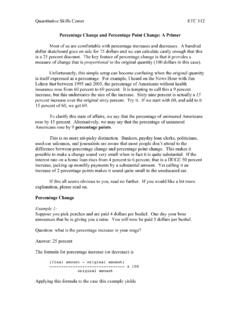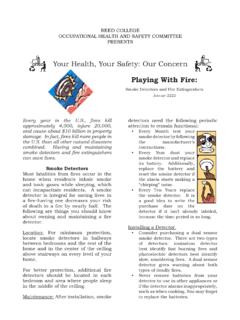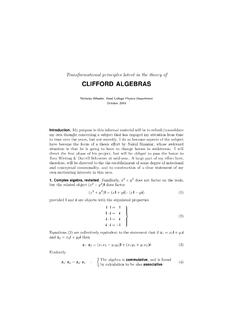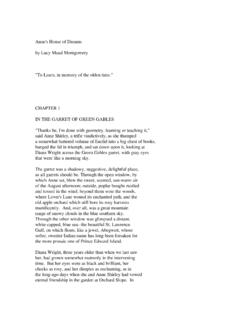Transcription of Imagination, Beauty, & Anne Shirley: Anne of Green Gables
1 1 imagination , beauty , & anne shirley : anne of Green Gables Claire Benjamin Marylhurst University Biographer Peggy Sullivan recounts author Lucy Maud Montgomery s struggles to publish her first novel: She received so many rejections for anne of Green Gables that for a time she put it away in a hatbox (8). Sullivan goes on to explain, however, that Montgomery determinedly persevered. Generations of readers have been thankful that she did so ever since. The novel s title character, anne shirley , is an embodiment of the female orphan archetype. In my work I have referred to stories that are woven from archetypal elements as special stories, and anne of Green Gables is just such a story.
2 When stories are special, they have the potential to be useful psychological tools for individuals. And when a reader uses mimetic imagination , which is the capacity to enter into a fictional world and make it feel real (Tatar 13), to interact with a special, archetypal story, wonderful opportunities for healing and growth are created. In particular, the orphan archetypal characteristics that anne embodies are examples of how non-traditional types of power can support those who are seemingly the most powerless. Using imagination , meditation on beauty and nature, and a determined belief in the joy of living, the small orphaned girl is able overcome an early childhood full of abuse and neglect.
3 anne is introduced to the reader as, a child of about eleven, garbed in a very short, very tight, very ugly dress of yellowish gray wincey .. Her face was 2 small, white and thin, also much freckled (Montgomery 11). Montgomery goes on: So far, the ordinary observer; an extraordinary observer might have seen that the chin was very pointed and pronounced; that the bug eyes were full of spirit and vivacity; that the mouth was sweet-lipped and expressive; that the forehead was broad and full; in short our discerning extraordinary observer might have concluded that no commonplace soul inhabited the body of this stray woman-child.
4 (11) With the paragraph above Montgomery encourages her readers to use imagination to become extraordinary observers as they are welcomed into the special story. And if the reader s facility with imagination is perhaps a little rusty, then anne s embodiment of the orphan archetype s nuanced relationship to imagination can guide her or him. The fifth chapter of Montgomery s 1908 novel begins with the following speech, delivered by the novel s stray woman-child. It is only thirty pages into the story and the reader is already well acquainted with young anne s self-assured approach to life: Do you know, said anne confidentially, I ve made up my mind to enjoy this drive.
5 It s been my experience that you can nearly always enjoy things if you make up your mind firmly that you will. Of course, you must make it up firmly. I am not going to think about going back to the asylum while we re having our drive. I m just 3 going to think about the drive. Oh, look, there s one little early wild rose out! Isn t it lovely? Don t you think it must be glad to be a rose? (Montgomery 30) anne refuses to dwell upon future circumstances over which she has no control. Instead, she grounds herself firmly in the present, I m just going to think about the drive (Montgomery 30) immerses herself in the beauty of the natural world around her, and engages her imagination .
6 As Poet John O Donohue states, Perhaps, through awakening our hearts to beauty , we can all come to know more intimately what John Keats meant when he wrote: I feel more and more every day, as my imagination strengthens, that I do not live in this world alone but in a thousand worlds (Letter, 18. Oct. 1818) (O'Donohue 9). This small girl, who is wanted by no one and is in immediate danger of being returned to an overcrowded orphan asylum, knows that the psychological strength gained from meditating on the beauty of nature will sustain her soul regardless of the challenges she faces. anne knows that her imagination helps her to live in a thousand worlds, of which the dreaded orphan asylum is only one.
7 In addition to using her imagination to engage creative visualization techniques, anne is also able to imagine the possibility that there is a place for her in the world. In relating her history to Marilla Cuthbert, who is considering adopting her, young anne explains that her mother died of fever when I was three months old .. And father died four days afterwards from fever, too (Montgomery 32). The romantic little orphan goes on to say, with a sigh, of her 4 deceased mother, I do wish she d lived long enough for me to remember calling her mother (Montgomery 32). From her parents death onward, anne explains, she is dependent upon the charity of a series of not-so-charitable foster homes: Father and mother had both come from places far away and it was well known they hadn t any relatives living (Montgomery 32).
8 In response to being utterly unwanted and with the use of her imagination anne is able to develop and maintain a sense of personal power that means she never feels victimized: anne sighed .. My life is a perfect graveyard of buried hopes. That s a sentence I read in a book once, and I say it over to comfort myself whenever I m disappointed in anything. I don t see where the comforting comes in myself, said Marilla. Why, because it sounds so nice and romantic, just as if I were a heroine in a book. (Montgomery 31) Using her active mimetic imagination , young anne is able to view herself as the star of her own story, which also means that there is a place for her in the world.
9 In other words, she employs her ability to experiment with the world as if she belonged to it, despite the fact that all practical evidence seems to indicate that she does not. In some way this echoes Mart n Prechtel s ideas about what he calls the Big Story: 5 The secret oneness of the Big Story is in the overwhelming details of its diversity, where every little person, beast, wind and misery is a necessary part of a greater churning dream. (4) anne , using imagination , maintains faith that her trials and tribulations are all part of a grander tale, of which she is the heroine, and that she is, hence, a necessary part of (Prechtel 4) the world.
10 Rather than feeling victimized despite the fact that she most certainly is a victim anne is thus empowered and sees the world as holding open space for her. Each triumph over her life s struggles results in the further tempering of anne s sense of personal power. In other words, anne is aware that she has been a victim most of her young life, but she refuses to succumb to a defeatist, victim mentality. On the contrary, she allows the traumatic experiences of her life to temper and strengthen both her imagination and her will to be hopeful. anne herself is assuredly aware of how indispensable imagination is to her in combatting the hardships of life.


